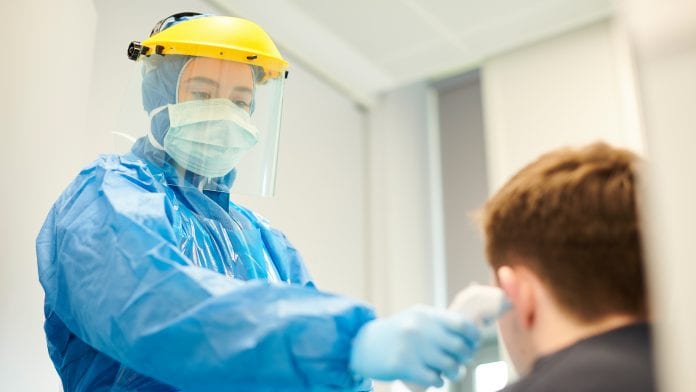
Can digital innovation boost infection control, treatment and testing at the point of care?
The response of healthcare systems and policymakers to the COVID-19 pandemic has sharpened focus on infection prevention and control at the point of care (POC), a key concern within healthcare environments. HEQ explores developments in point of care technologies and practices which may help protect patients and staff from the spread of disease.
Digital POC technology could improve decision making
A 2019 study focusing on the use of digital technology to support point of care diagnostics and treatment in rural and resource-limited areas found that the integration of novel digital technology solutions into clinical and ambulatory settings improved the ability of care practitioners to reach an initial diagnosis. The research, which was conducted in rural West Virginia, analysed the use of ‘technology first’ assessment protocols in diagnosing and determining treatment for common acute and chronic cardiovascular conditions. Physicians participating in the study reported that the use of digital solutions, including wireless vital sign monitors and smartphone-compatible pocket ultrasound devices, improved their ability to make prompt, accurate diagnoses of conditions such as atrial defibrillation and heart failure.
Barcode scanning shores up patient safety
Six NHS hospital trusts across the UK have implemented the Scan4Safety initiative, a point of care barcode scanning programme overseen by NHSX. Scan4Safety equips patients with a unique barcode on a wristband, which is then scanned at each stage of the care pathway, in order to document their treatment, the equipment used – which is also scanned and the corresponding patient and location data recorded – and the staff members responsible for their care. The process offers evident benefits in terms of inventory management and oversight, as well as reducing the amount of staff hours spent on stock management, with up to 140,000 clinical hours returned to patient care across the six trusts. Trusts which have adopted the programme report observing measurable improvements to patient safety through accurate recall and full traceability; decreased risk of drug error; and improvements to routine patient observations.
Lord David Prior, chair of NHS England, said: “Barcodes are commonplace in most industries and been around for a long time. It is time they became commonplace in the NHS. They offer traceability, efficiency savings and greater patient safety. We live in a world in which digital technology has already fundamentally changed the banking industry, the retail industry, and many others. It offers a similar opportunity in healthcare. Barcodes are a small but essential part of that revolution. We need to embrace it, now.”
The importance of rapid testing
The healthcare sector has recorded significant improvements to patient management, particularly in terms of access to diagnostic services, following the implementation and digitalisation of point of care testing facilities; with the most drastic improvements reported in areas with limited clinical resources or minimal access to laboratory infrastructure.
When left unsupported by digital innovation, increasing the implementation of infection testing at the point of care – while it appears to be the optimal solution for patients, in principle – risks placing undue strain on healthcare services which are already wildly overstretched and underfunded. Analogue testing protocols intensify the demand for supply management and quality assurance, while necessitating additional staff training. It is therefore imperative to integrate digital technologies into point of care testing systems to alleviate the burden on frontline staff and maintain high quality standards – in addition to the benefits digital innovation can offer for staff welfare and morale, the safety of both frontline workers and patients can be shored up through the provision of remote testing and diagnosis facilities, where these are feasible.
Digitising the flow of data
The ongoing shift towards digitalisation in healthcare systems has had documented advantages both in terms of data collection and in terms of the storage and analysis of patient data and test results. The implementation of ‘connected diagnostics’ through algorithms, Internet of Things (IoT) technologies and machine learning systems has enabled healthcare professionals to benefit from standardised analysis and interpretation of test results, meaning treatment and care pathways become more consistent and the risk of human error is minimised. Connected point of care devices can be monitored remotely and programmed to issue alerts in the event of data trends which may indicate outbreaks of disease or infection.
In addition to streamlining the flow of data, the integration of digital technologies within the health and care sectors has had a significant impact on the security and reliability of data storage. More and more healthcare providers around the world are adopting Electronic Health Records (EHRs), which digitally store patient and population data and can be shared – within the bounds of data protection and anonymity – between services. The ability to view a patient’s medical history instantly has proved valuable for emergency services, as well as care providers, with immediate access to patient data allowing for better preparation on the part of the receiving hospital; hospitals which have implemented EHRs also report smoother transition of patients between departments and a reduced need for extraneous tests. Meanwhile, EHRs enable the streamlined sharing of anonymised and disaggregated data in research settings, thereby facilitating data collection and analysis in clinical research.
In principle, EHRs minimise the siloing of clinical data – however, this is only truly the case if they are widely integrated in healthcare systems. The Finnish health sector can boast 100% EHR coverage across hospitals and other clinical settings, with a single centralised archive storing patient records from around the country; however, many other EU Member States operate EHR programmes at a regional level, meaning essential patient data may not be compatible or transferrable between states or municipalities.
This article is from issue 14 of Health Europa. Click here to get your free subscription today.
























